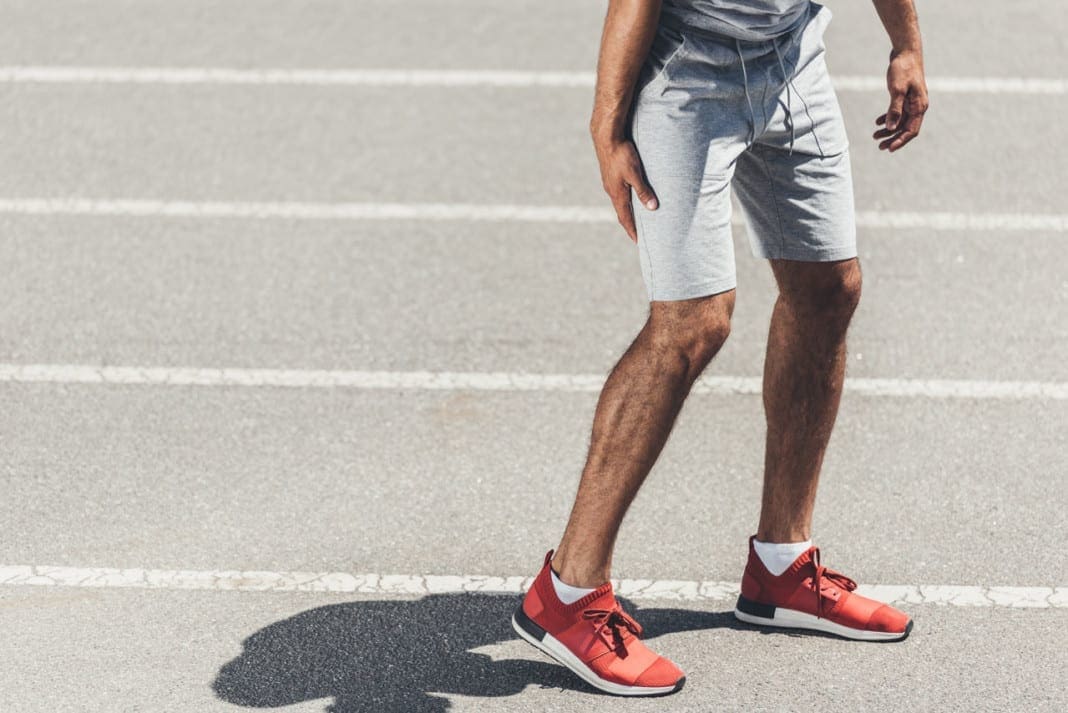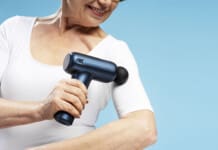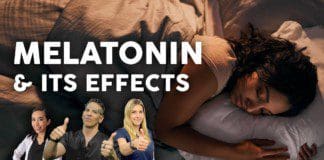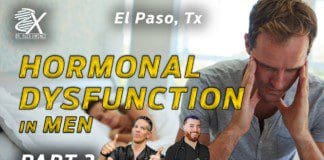Traditional medical treatment for sciatica can sometimes be not as effective or ineffective for individuals, but nerve flossing is an option that could help. Flossing is not something individuals expect to hear from a medical professional treating their sciatica. However, when sciatica does not respond to common treatment methods like light physical activity or medications, a physician, chiropractor, or physical therapist might suggest combining traditional treatment with nerve flossing to alleviate sciatic nerve pain.
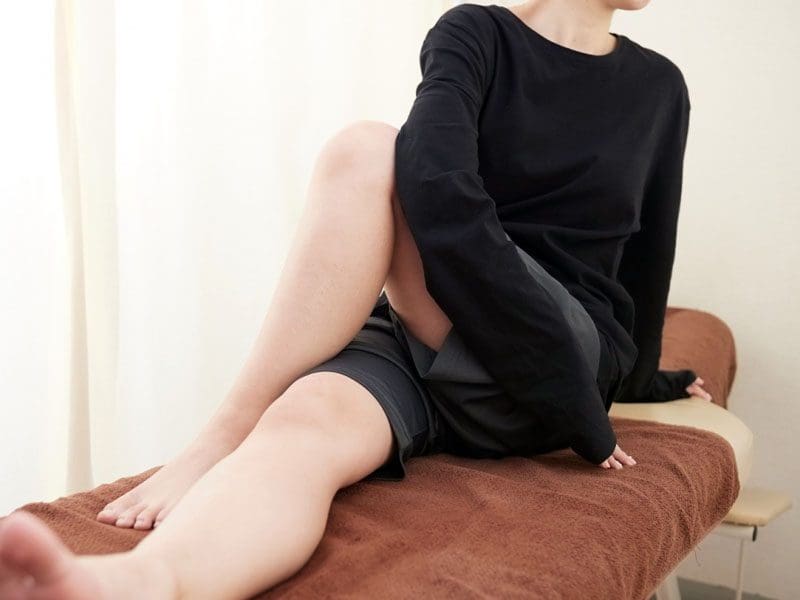
Table of Contents
Nerve Flossing
The nerves can get jammed/stuck between the tissues and cannot move, flex as they should. Nerve flossing involves performing gentle exercises to mobilize and stretch the nerves that help reduce irritation, inflammation, and improve mobility, especially in the hips. Nerve flossing is also known as:
- Neural gliding
- Nerve gliding
- Nerve mobilization
The exercises can be done at home with no equipment and simple instructions. When used in combination with other treatments, like chiropractic and physical therapy, the effectiveness is increased. Consult with a doctor or doctor of chiropractic for an accurate diagnosis because what is causing sciatica helps significantly determine the best treatment plan.
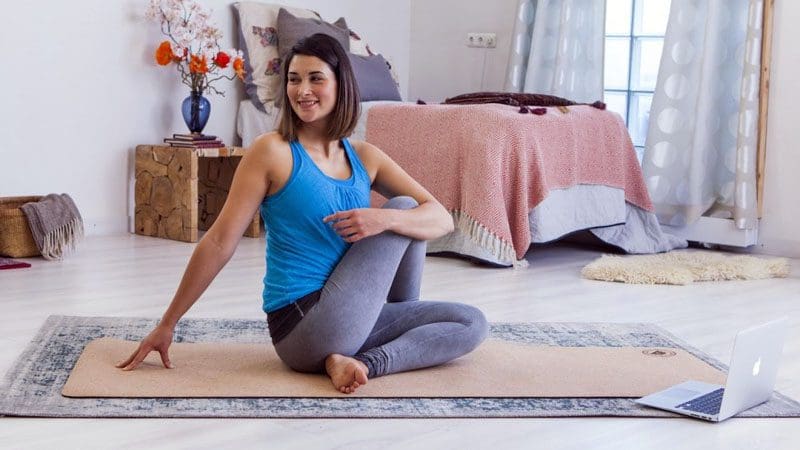
Guidelines
These are simple exercises, but they are still exercises that require following safety guidelines to prevent injury or pain. These include:
- The body will need time to adjust to new exercises, so individuals should start slow.
- Only a few repetitions should be done at a time
- Gradually increase
- Stop if pain presents with any of the exercises and report the pain to a doctor or chiropractic physical therapist to see if there is a problem with how the exercises are being performed or if the exercises should be done later on after further treatment.
- Focus on staying relaxed, as tensing up the muscles decreases the effectiveness
- Breathing properly is key. Individuals unknowingly stop breathing when doing exercises, which is not healthy. Breathe deep in and out.
Nerve Exercises
True nerve flossing is an active movement with motion; otherwise, it is just stretching.
Mobilizing floss
- Lie on the floor with both knees bent, feet flat on the floor, and with space at hip-width
- A flat pillow can be used for the head if it makes it more comfortable
- Tuck the chin in, and be sure to keep the upper body relaxed throughout the exercise
- Pull the right leg in towards the chest
- Keep holding behind the right knee
- Slowly straighten the leg until there is a comfortable stretch
- Slowly return the knee to the starting position
- Breathe deeply, slowly, and try not to press the lower back into the floor
- Lower the leg back towards the chest, then lower it back to the starting position
- Perform with the left leg
- Complete five repetitions on each side
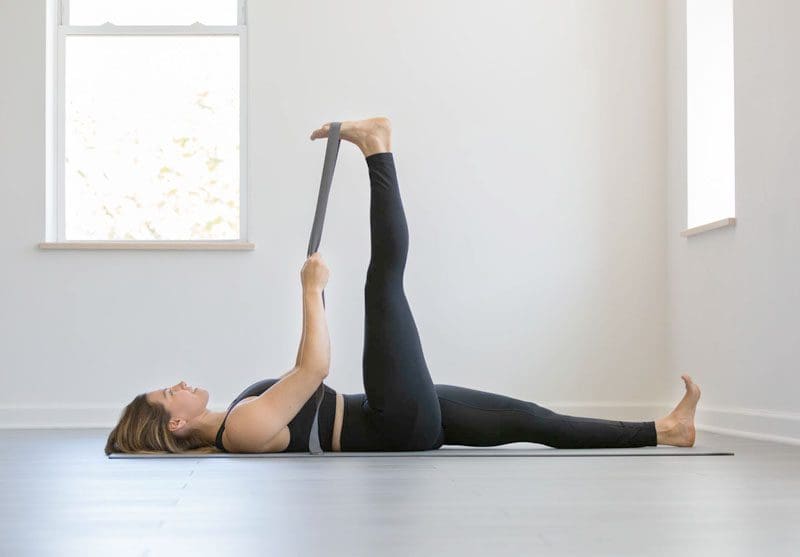
Seated nerve floss
- Sitting upright in a chair, knees spaced hip-width, feet flat on the floor, and face forward.
- Extend the left leg
- Flex the foot toward the body
- Extend the head up and back, looking up at the ceiling
- Gently lower head and leg down, tucking the chin into the chest while bending the leg slightly backward
- Extend and lower head at the same time when extending and lowering the leg
- Perform 10 repetitions
- Switch legs and repeat the exercise
- Perform exercise 2–3 times every day
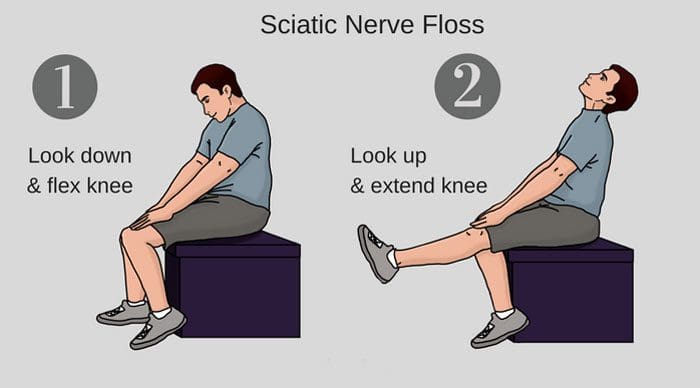
Hamstring floss
- Stand up straight, raise the right leg onto a step or other stable surface while keeping the leg straight and toes pointed up.
- Keeping the back straight, tilt the head and neck forward until there is a slight pull/stretch in the back
- Point the toe and bring the chin to the chest
- Flex the foot and return
- Repeat five times
- Return to starting position
- Switch legs
- Repeat three sets on each leg
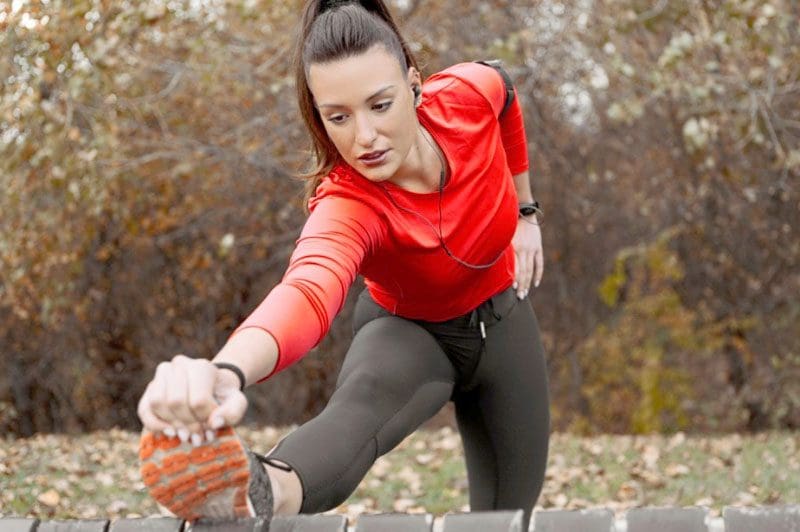
Exercise for Piriformis Syndrome
The piriformis muscle joins the base of the spine to the upper leg. Because this muscle is so close to the sciatic nerve, any irritation or compression can also cause piriformis syndrome. Piriformis syndrome can cause radiating pain to the:
- Hips
- Buttocks
- Hamstrings
- Pain when sitting down or walking upstairs
Nerve flossing can also help relieve the symptoms increasing flexibility and range of motion.
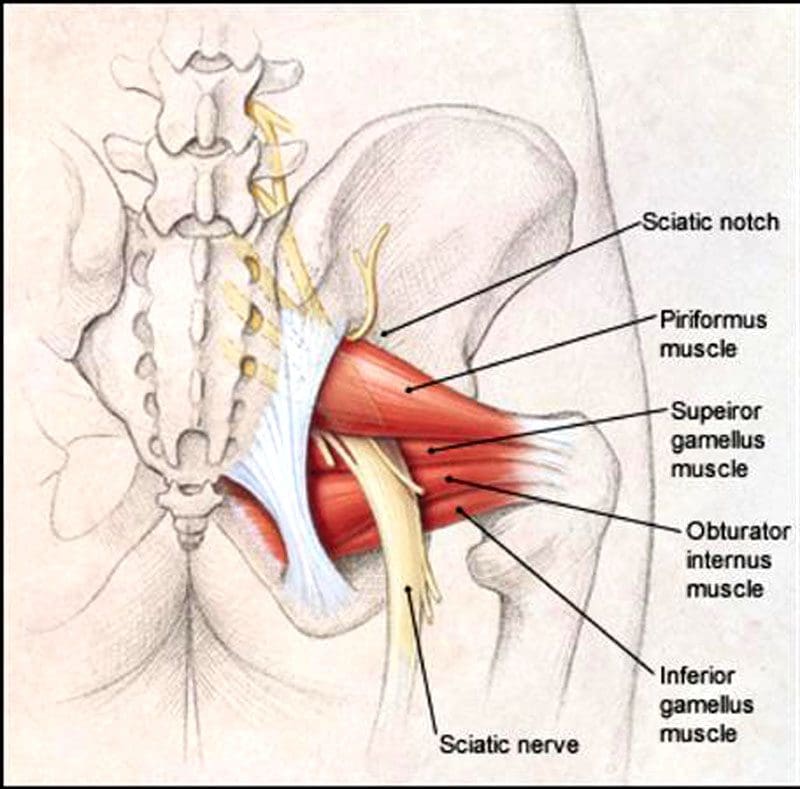
Mobilizing stretch
- Lie flat on the floor on the back
- Extend both legs
- Bend the right leg and bring it up
- Hold the right knee and foot
- While holding, gently pull the leg across the right side of the body and up toward the right shoulder.
- Return to the original position
- Repeat five times
- Gently lower the right leg
- Switch legs
- Complete five repetitions on each side two to three times a day
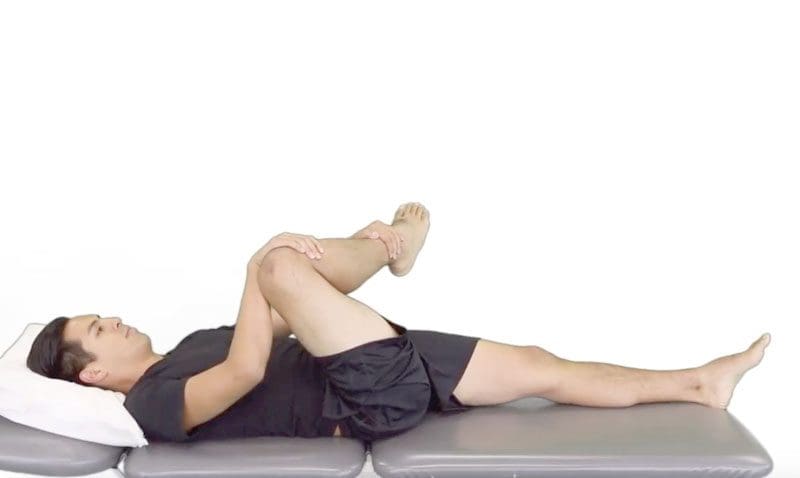
Risks
These exercises are not about pushing the body to its limits or in a way that causes pain. They are designed to rehabilitate, stretch, and strengthen the sciatic nerve making risks for further injury minimal. If there are still concerns about the safety of nerve flossing exercises, check with a doctor, doctor of chiropractic, or physical therapist. If there is severe nerve damage or undiagnosed acute pain, nerve flossing could worsen symptoms. Nerve flossing for acute cases of nerve irritation is not recommended as this can cause nerve root aggravation with the stretching/pulling.
Flossing for Sciatica
More research is needed on how nerve flossing can best help sciatica. It is an easy, natural, medication-free treatment that can help soothe irritated and compressed nerves, improve mobility and flexibility.
Body Composition
Tracing sources of fatigue
There is a difference between being tired after a long day working, playing, etc., and being tired regularly. This can be referred to as Chronic Fatigue Syndrome, a clinical condition where fatigue lasts longer than 6 months. With acute, non-clinical fatigue, it is typical to experience many symptoms that hamper an individual’s ability to function. Symptoms can include:
- Lethargy
- Slow reaction time
- Reduced appetite
- Moodiness
- Memory Loss
- Dizziness
- Cortisol levels increased
With hectic schedules, sources of fatigue begin to pile up along with unhealthy diet choices that stem from:
- No time for a well-balanced breakfast
- No time or forgetting to make a healthy lunch equals
- Fast food patterns
- Unhealthy snacks
References
Anikwe EE, Tella BA, Aiyegbusi AI, Chukwu SC: Influence of Nerve Flossing Technique on acute sciatica and hip range of motion, International Journal of Medicine and Biomedical Research, 4(2) May-August 2015, www.ijmbr.com
Jeong UC, Kim CY, Park YH, Hwang-Bo G, Nam CW. The effects of self-mobilization techniques for the sciatic nerves on physical functions and health of low back pain patients with lower limb radiating pain. J Phys Ther Sci. 2016;28(1):46-50. doi:10.1589/jpts.28.46
Professional Scope of Practice *
The information herein on "Nerve Flossing Exercises for Sciatica" is not intended to replace a one-on-one relationship with a qualified health care professional or licensed physician and is not medical advice. We encourage you to make healthcare decisions based on your research and partnership with a qualified healthcare professional.
Blog Information & Scope Discussions
Welcome to El Paso's Premier Wellness and Injury Care Clinic & Wellness Blog, where Dr. Alex Jimenez, DC, FNP-C, a Multi-State board-certified Family Practice Nurse Practitioner (FNP-BC) and Chiropractor (DC), presents insights on how our multidisciplinary team is dedicated to holistic healing and personalized care. Our practice aligns with evidence-based treatment protocols inspired by integrative medicine principles, similar to those found on this site and our family practice-based chiromed.com site, focusing on restoring health naturally for patients of all ages.
Our areas of multidisciplinary practice include Wellness & Nutrition, Chronic Pain, Personal Injury, Auto Accident Care, Work Injuries, Back Injury, Low Back Pain, Neck Pain, Migraine Headaches, Sports Injuries, Severe Sciatica, Scoliosis, Complex Herniated Discs, Fibromyalgia, Chronic Pain, Complex Injuries, Stress Management, Functional Medicine Treatments, and in-scope care protocols.
Our information scope is multidisciplinary, focusing on musculoskeletal and physical medicine, wellness, contributing etiological viscerosomatic disturbances within clinical presentations, associated somato-visceral reflex clinical dynamics, subluxation complexes, sensitive health issues, and functional medicine articles, topics, and discussions.
We provide and present clinical collaboration with specialists from various disciplines. Each specialist is governed by their professional scope of practice and their jurisdiction of licensure. We use functional health & wellness protocols to treat and support care for musculoskeletal injuries or disorders.
Our videos, posts, topics, and insights address clinical matters and issues that are directly or indirectly related to our clinical scope of practice.
Our office has made a reasonable effort to provide supportive citations and has identified relevant research studies that support our posts. We provide copies of supporting research studies upon request to regulatory boards and the public.
We understand that we cover matters that require an additional explanation of how they may assist in a particular care plan or treatment protocol; therefore, to discuss the subject matter above further, please feel free to ask Dr. Alex Jimenez, DC, APRN, FNP-BC, or contact us at 915-850-0900.
We are here to help you and your family.
Blessings
Dr. Alex Jimenez DC, MSACP, APRN, FNP-BC*, CCST, IFMCP, CFMP, ATN
email: coach@elpasofunctionalmedicine.com
Multidisciplinary Licensing & Board Certifications:
Licensed as a Doctor of Chiropractic (DC) in Texas & New Mexico*
Texas DC License #: TX5807, Verified: TX5807
New Mexico DC License #: NM-DC2182, Verified: NM-DC2182
Licensed as a Multi-State Advanced Practice Registered Nurse (APRN*) in Texas & Multistate
Multistate Compact RN License by Endorsement (42 States)
Texas APRN License #: 1191402, Verified: 1191402 *
Florida APRN License #: 11043890, Verified: APRN11043890 *
* Prescriptive Authority Authorized
ANCC FNP-BC: Board Certified Nurse Practitioner*
Compact Status: Multi-State License: Authorized to Practice in 40 States*
Graduate with Honors: ICHS: MSN-FNP (Family Nurse Practitioner Program)
Degree Granted. Master's in Family Practice MSN Diploma (Cum Laude)
Dr. Alex Jimenez, DC, APRN, FNP-BC*, CFMP, IFMCP, ATN, CCST
My Digital Business Card
RN: Registered Nurse
APRNP: Advanced Practice Registered Nurse
FNP: Family Practice Specialization
DC: Doctor of Chiropractic
CFMP: Certified Functional Medicine Provider
IFMCP: Institute of Functional Medicine
CCST: Certified Chiropractic Spinal Trauma
ATN: Advanced Translational Neutrogenomics

